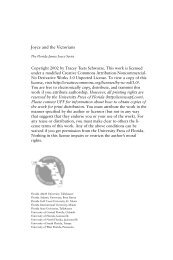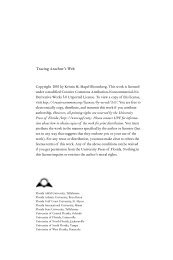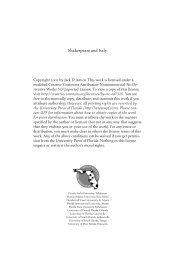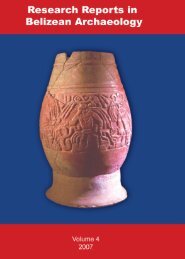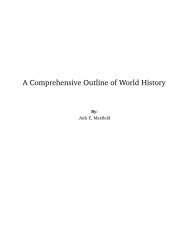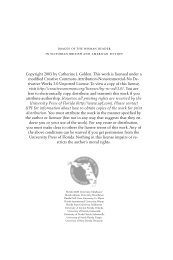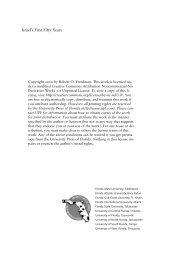Bernard Shaw's Remarkable Religion: A Faith That Fits the Facts
Bernard Shaw's Remarkable Religion: A Faith That Fits the Facts
Bernard Shaw's Remarkable Religion: A Faith That Fits the Facts
Create successful ePaper yourself
Turn your PDF publications into a flip-book with our unique Google optimized e-Paper software.
Major Barbara 127<br />
picture, but Major Barbara is presented frankly as a parable. 2 One expects<br />
a parable to be simple and—at least relatively—uncluttered. Part of <strong>the</strong><br />
problem is that Shaw is using “real people I have met and talked to” as a<br />
means of telling his tale (Collected Screenplays 485). <strong>That</strong> makes <strong>the</strong> play<br />
much more interesting, but it complicates <strong>the</strong> task. Even more important is<br />
that <strong>the</strong> moral of this parable is not simple; Shaw crams a great deal into an<br />
evening’s traffic on <strong>the</strong> stage. Even <strong>the</strong> action that emerges when one steps<br />
back far enough from <strong>the</strong> play is not without its peculiarities. The mutual<br />
attempts at conversion do not even proceed in a direct and straightforward<br />
manner but are indirect and oblique. When Undershaft visits <strong>the</strong> Salvation<br />
Army shelter, Barbara does not spend any time trying to convert her fa<strong>the</strong>r;<br />
she gives her entire attention to <strong>the</strong> conversion of Bill Walker. When<br />
Barbara comes to <strong>the</strong> munitions factory, her fa<strong>the</strong>r spends only a few minutes<br />
talking to her; he devotes most of his time to converting Cusins, despite<br />
<strong>the</strong> remarkable, even obsessive, interest he had shown in Barbara<br />
during <strong>the</strong> two previous acts.<br />
We have barely touched on <strong>the</strong> difficult philosophical issues of <strong>the</strong> play.<br />
It is not surprising that readers are confused by it, but at a good performance<br />
audiences are unaware of <strong>the</strong>se difficulties. The play has a remarkable<br />
coherence in spite of all of <strong>the</strong>se apparent irrelevancies and discontinuities.<br />
All of <strong>the</strong> complexities are resolved in <strong>the</strong> throughline of <strong>the</strong> play,<br />
which is ultimately simple, consistent, and unambiguous. A careful look at<br />
both <strong>the</strong> overall action and <strong>the</strong> details shows how <strong>the</strong>y come toge<strong>the</strong>r in an<br />
almost perfect whole.<br />
An Illusory Conflict<br />
The parable opposes two sets of seemingly irreconcilable principles, polar<br />
opposites that must be eternally at war: spirit against matter, religion<br />
against a<strong>the</strong>ism, altruism versus egoism, heroic idealism opposed to cynical<br />
pragmatism. The triumph of Undershaft—or at least <strong>the</strong> triumph of<br />
Undershaft and Lazarus, Ltd., over <strong>the</strong> Salvation Army—can be interpreted<br />
as Chesterton saw it: “Major Barbara . . . contains a strong religious<br />
element; but when all is said, <strong>the</strong> whole point of <strong>the</strong> play is that <strong>the</strong> religious<br />
element is defeated” (190). A more popular view, at least among<br />
Shaw’s fans, is that <strong>the</strong> play represents a Hegelian dialectic with <strong>the</strong> succession<br />
of Barbara and Cusins to <strong>the</strong> Undershaft throne as <strong>the</strong> final syn<strong>the</strong>sis<br />
of spirit and power, idealism and pragmatism, growth and destruction<br />
(for example, Whitman 223–30). Although some, like Wisenthal, feel<br />
that Shaw successfully presents Cusins as an advance on Undershaft (and



